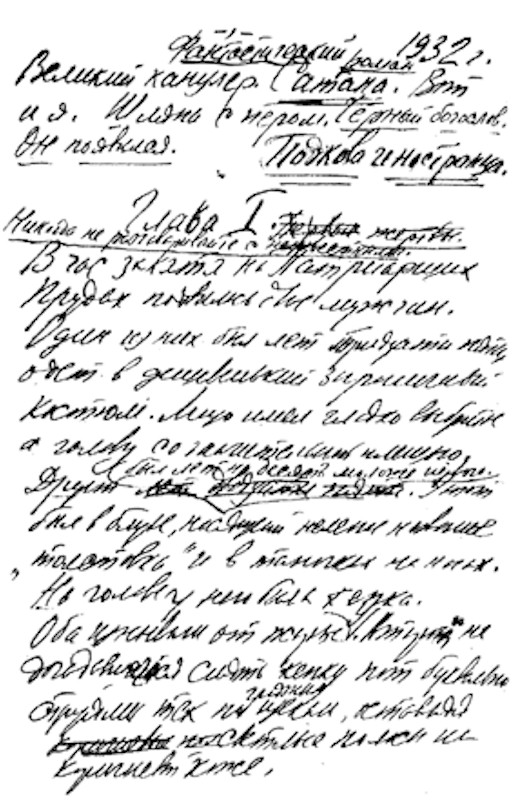The Genesis of the Novel
Introduction
Mikhail Afanasievich Bulgakov (1891-1940) began writing The Master and Margarita at the end of 1928, or in the beginning of 1929. This can be deduced from the fact that he presented the text of Мания фурибунда [Maniya furibunda] or Raging Madness on May 8, 1929 under the pseudonym K. Tugay to the publishing house Nedra. It was the fourth chapter of The Engineer's Hoof, the second version of the novel that would later become known under the title The Master and Margarita. The publishing house refused to publish the text.
1929 was the year when Bulgakov's theatre plays were removed one after the other from the scenes and he himself became the target of a press campaign aimed at ruining him as a writer. The representations of The Days of the Turbins at the Moscow Art Theater MKhAT were halted. That play was a theatre adaptation of Bulgakov's novel The White Guard, and has been performed with great success since October 5, 1926. Despite the fact that Joseph Vissarionovich Stalin (1878-1953) seemed to love this piece, it was removed on February 26, 1929. In that respect nothing fundamentally changed in the years that followed, as none of his books were published and, with the exception of his adaptation of Dead Souls and some representations of Molière, his plays did not make it to the stage.
The Master and Margarita was thus written in a very dark political context, a hopeless situation on a professional and human level. When the author continued to work sporadically on the book in 1931, he wrote «1929-1931» on the cover, but in The Prince of Darkness, the sixth version of the novel from 1937, he wrote «1928-1937».
He would continue to work on it even until a few weeks before his death in 1940. Thus, The Master and Margarita would accompany him through the most difficult years of his life.
The archives of Mikhail Bulgakov have remained inaccessible for a long time. Moreover, Bulgakov kept some of his rough drafts, but destroyed others. The first two versions of the novel are known to us from two notebooks that were partially torn. Philologist Marietta Omarovna Chudakova (°1937) was the first Russian researcher to attempt to reconstruct these first texts in 1977. But the book's history took twelve years, it had at least six different versions, sometimes very complex, and sometimes opposed to each other. They show many interruptions and far-reaching revisions.
And sometimes new discoveries are mde. An example of this is the diary that Bulgakov kept between 1921 and 1925. It was confiscated in 1926, and did not surface until much later. The typewritten copies were not published until 1990. It is therefore possible that sources may emerge which may provide a surprising new perspective on the novel and its developments.
A novel about the Devil
In the book My Life with Mikhail Bulgakov, which was written in 1968-1969 by Lyubov Yevgenyeva Belozerskaya (1894-1987), Bulgakov's second wife, we can read that Bulgakov got the idea of writing a novel about the devil in Moscow from Natalia Abramovna Lyamina-Ushakova (1899-1990), the wife of his best friend Nikolay Nikolaevich Lyamin (1892-1941).
Natalia had designed the cover of the book Venediktov, or the memorable events of my life, a story of 64 pages written by Professor Alexander Vasilyevich Chayanov (1888-1937) in 1922. She was astounded to see that the hero of Chayanov's story had the name Bulgakov. And Mikhail Bulgakov was «no less astounded by this coincidence».
It should be said, some elements of Venediktov are indeed reminiscent of The Master and Margarita. The narrative is about Satan's presence in Moscow, the devil meets the hero Bulgakov in the Medox Theatre, and Bulgakov admires the gigantic Pashkov House «the jutting top of which vanished upwards». Belozerskaya also found similarities in both the content and linguistic structure of the beginning of Chayanov's story and Bulgakov's first drafts of The Master and Margarita from 1928-1929. The similarites were sufficient to make Belozerskaya conclude: «I can say that this little story gave M.A. the original idea and creative impulse for the novel The Master and Margarita».
Bulgakovs 'sources
Boelgakov heeft heel wat bronnen geraadpleegd vooraleer aan De meester en Margarita te beginnen. Hij verdeelde ze in twee rubrieken die hij respectievelijk betitelde als God en De duivel. De belangrijkste waren, naast de canonieke Evangeliën:
The Life of Christ
Farrar, Frederic [en] - 1874
Das Leben Jesu, kritisch bearbeitet
David Strauss [de] - 1835
La Vie de Jésus
Ernest Renan [fr] - 1863
Le Procurateur de Judée
Anatole France [fr] - 1892
The Gospel of Nicodemus
Nicodemus [en] - 1924
The Brockhaus-Efron encyclopaedia
Russian encyclopaedia [ru] - 1906
The History of the relation of Man with the Devil
Mikhail Orlov [ru] - 1904
Most of these texts can be downloaded in the Archives section of this website.
He made annotations of whatever he found in these sources and which found its way to the novel - or disappeared from it again.
One of his original manuscripts shows several working titles that Bulgakov had in mind for his masterpiece: Великий канцлер [Beliky kantsler] or The Great Chancellor, Сатана [Satana] or Satan, Вот и я [Vot i ya] or Here I am, Шляпа с пером Shlyapa s perom] or The Hat with the Feather, Черный богослов [Chorny bogoslov] or The Black Theologian, Он появился [On poavilsya] or He Has Appeared, Подкова иностранца [Podkova inostrantsa] or The Stranger's Horseshoe, Он явился [On yavilsya] or There He Is! Пришествие [Prishestviye] or The Apparition, Черный маг [Chorny mag] or The Black Magician and Копыто консультанта [Kopyto konsultanta] or The Counselor's Hoof. The title Вот и я [Vot i ya] or Here I am refers to the exclamation «Me Voici!». With this exclamation the Devil appears for Faust in the opera of the same name by Charles Gounod (1818-1893).
Bulgakov struggled most with the end of the story, more specifically about what reward the master should receive at the end. There are still pieces of manuscript in which he clearly establishes the thematic link between himself, the master and Pilate, as well as between the historical passages and the Moscow passages, but they did not make it to the final version of the novel.
1. The Black Magician (1928-1929)
The very first version of The Master and Margarita was found in a notebook entitled Черный маг. Черновики романа. Тетрадь 1.1928-1929 гг. [Chorny mag. Chernoviki romana. Tetrad 1. 1928-1929] or The Black Magician. Concepts for the novel. Notebook 1. 1928-1929.
Very little of this version has survived. Many pages were torn, leaving only a few fragments of words or sentences on most of them. Only a dozen pages with excerpts from five of the fifteen chapters remained intact.
It is no longer possible to find out how or when the rest of the pages disappeared. In any case, we see in what remains of it that the story was permeated with political motives and that it was Bulgakov's answer to the persecutions he endured.
The story begins with a foreword by a narrator speaking in the first person. In the best tradition of the chroniclers, he humbly apologizes for his clumsiness and lack of professionalism. But, as he says, «the strange nature of the events justifies the decision to take the pen and I swear to my honour, as soon as I pick up the pen to describe these monstrous events, I feel imbued with a feeling of horror. One thing, however, worries me and that is that, because I am not a writer, I risk not being able to relate them in a coherent way ».
Vladimir Mironovich Berlioz is the editor-in-chief of the magazine The Godless and explains to the well-known poet Antokha Bezrodny that he will have to write a poem to accompany a caricature of Jesus looking as an exploiter of the proletariat. Bezrodny means «without family», after which his name will change to Ivanushka Popov, Ivanushka Bezrodny and finally Ivan Bezdomny, «he homeless». While Berlioz is explaining, Antokha mechanically draws a Jesus figure in the sand with the tip of his shoe.
Then a stranger appears, a stranger who is amazed by hearing that they don't believe in any God, and who tells the story of the day of the crucifixion which he had witnessed. The story is told in chapter 2, which is entitled The Gospel of Woland. The Pilate story is situated entirely in this chapter and is not yet the autonomous text we know today.
After that, the mysterious stranger challenges Antokha to prove his atheism by obliterating the drawing of Jesus he made in the sand. But Antokha hesitates, sparking a whole discussion that is followed by the death of Berlioz. Without knowing how he got here, Antokha ends up in Saint Basil's Cathedral, where Ivan the Terrible (1530-1584) comes out of the building. Then, in Chapter 4, there is the scene in Griboedov and the poet ends up in the psychiatric hospital. The first title of this chapter was In Griboedov's Hut, then it became Intermezzo in Griboedov's Hut, and finally Manu Furibunda. It is this chapter that was presented to Nedra magazine in 1929, but they refused to publish it.
In 1994, film director Yuri Kara used the scene with the drawing of Jesus in the sand in his film Master i Margarita. You can watch that scene here.
Some elements of the novel, such as the scene in Griboedov, will invariably withstand the different versions, but others change greatly or even disappear. The character Stepanida Afanassievna, for example, is a female poet from the first draft who spreads the news of Berlioz's death over the phone in a chapter called На ведьминой квартире [Na bedminoy kvartirye] or In the Witch's Apartment. This character will disappear later. Also interesting is the character of the demonologist Fessia, a kind of predecessor of the master. In a later version, when the master takes his final form, Fessia disappears again.
Noteworthy is the sixth chapter, Марш фюнебров [Marsh Fyunebrov] or The March of the Funerals, in which the poet Ivanushka, who had escaped from the hospital, came to disturb Berlioz's funeral procession. This chapter is no longer found in the later versions of the novel.
The first version already shows the enormous efforts that Bulgakov made to come up with the names of the characters and the locations. Styopa Likhodeev is transported to Vladikavkas and not to Yalta, and his name is Garassi Pedulaev in the first version. His staff members, who will be called Rimsky and Varenukha in the final version, are here here Tsupilioti (later changed in succession to Sukovsky, Bibliyesky, Robinsky and finally Rimsky) and Newton (later changed to Nuton, Karton, Blagovest and finally Varenukha). The unfortunate presenter Bengalsky is called here Piotr Alexeevich Blagovest.
2. The Engineer's Hoof (1928-1929)
The second version of Bulgakov's The Master and Margarita was entitled Копыто инженера. Черновики романа. Тетрадь 2. 1928-1929 гг. [Kopyto Inzhenera. Chernoviki novel. Tetrad 2. 1928-1929] or The Engineer's Hoof. Concepts for the novel. Notebook 2. 1928-1929. This version also showed traces of other titles that Bulgakov had thought of: Гастроль (Воланда) [Gastrol (Volanda)] or The tour (from Woland), Сын В [Syn V] or The Son of W and Жонглер с копытом [Zhongler s kopytom] or The juggler with the hoof.
Despite the fact that only two chapters are more or less completely preserved in this second notebook, it is clear that it already contains the content that will be further developed in subsequent editions. The two preserved chapters are Евангелие от Воланда [Evangeliye ot Volanda] or The Gospel of Woland, with the Pilate story, and Шестое доказательство [Shestoye dokazatelstvo] or The Sixth Proof, with the beheading of Berlioz.
A very incomplete text of one other chapter has been preserved. It was from the aforementioned Мания фурибунда [Maniya furibunda] or Raging Madness which was presented to the publishing house Nedra.
3. A Scary Saturday Night (1929-1931)
In the spring of 1930 Bulgakov destroyed the first two versions of his novel. It was the period when his plays were completely banned and when he wrote his letter to the Soviet government. He asked to be allowed to go abroad or at least, as he put it: «to get a job in my specialty and to join a theater in the position of director». On October 17, Stalin called him in person and a few weeks later Bulgakov became an assistant director at the Moscow Art Theater MKhAT. In his letter Bulgakov made an allusion to The Engineer's Hoof: «And I personally, with my own hands, threw the draft of a novel about the devil into the fire».
The work in the theater was not very satisfying and Elena Sergeevna Shilovskaya (1893-1970), born Nyurenberg, with whom he had started a relationship in February 1929, had broken up with him at the insistence of her husband. Two thin notebooks entitled Вечер страшной субботы. Черновые наброски к роману. 1929-1931 гг. [Vecher strazhnoy subboty. Chernoviye nabrosky k romanoye. 1929-1931] or A Scary Saturday Night .. Drafts of the novel 1929-1931 date from that time. They contain the preparations for Большой Канцлер [Bolshoy Kantsler] or The Great Chancellor, the next fully written version of the novel.
In these «drafts» Bulgakov dated the Moscow story in the novel for the first time. First he situated the events in Griboedov on Saturday, June 24, 1943. Later he changed that to Saturday, June 24, 1935. This has to do with a prediction by the well-known French pharmacist and astrologer Michel de Nostredame (1503-1566), better known as Nostradamus. You can read more about this in our Annotations per Chapter.
The poet Ryukhin appears and there is a sketch of one of the last chapters, Полет Воланда [Polet Wolanda] or The Flight of Woland, where it is noted: «Lord, help me to end my novel, 1931». In the same excerpt, we read the sentence «You will meet Schubert and the clear mornings», which implies that there is a character present who has not yet been named, but who would become the master. In 1931 the term master was assigned to Woland. It will not be given to Margarita's lover until 1936 when the master becomes the narrator of the last fragments of the Pilate story. The name of Margarita also appears for the first time in this chapter in the sentence «... Margarita cried happily».
Finally, in this version we are also introduced to the demonic characters Fagot and Behemoth for the first time.

Manuscript with different titles
4. The Great Chancellor (1932-1934)
Великий канцлер [Belinki kantsler] or The Grand Chancellor is the longest and most complex version of The Master and Margarita. Bulgakov started working on it again in October 1932 during a trip to Leningrad. He had traveled there with Elena Sergeevna, whom he had just married. He started it without his scraps and notes. «I know it by heart», he said to Elena Sergeevna. That would become a phrase that is also used by the master in the final version of the novel.
The work would last, with many interruptions, until the autumn of 1936. New possible titles emerged such as Подкова иностранца[Podkova inostrantsa] or The Stranger's Horseshoe and Театральный роман [Teatralny roman] or Theatrical novel.
In one of the 1933 variants, the hospitalized Ivanushka asked for a Gospel, after which Woland sat down next to his bed at night to tell him his Gospel. But in the end, the unnamed poet became the author of a novel that matched The Gospel of Woland, and the biblical story began to be fragmented. Pieces of it were removed from the second chapter, and moved to chapters 11 and 16. Other interventions also began to evolve towards what the novel would ultimately look like: the love between the master and Margarita, the departure of Margarita to the Sabbath, and the reappearance of the master.
Some chapters were written in Leningrad in June 1934. The manuscripts of the time still show how the writer hesitated about the sequence of the scenes and how he still struggled with the ending, especially with regard to the reward the master should receive at the end of the last journey. The outcome was first described in July 1936 in Chapter 37 entitled The Last Flight.
The draft version was finished in October 1934. The novel had 37 chapters.
5. Fantastic novel (1934-1936)
Although the novel was «finished», Bulgakov still rewrote several pieces until the summer of 1936. The result was a manuscript entitled Фантастический роман. Главы, дописанные и переписанные 1934-1936 гг [Fantastichesky roman. Glavi, dopisanniye i perepisanniye 1934-1936] or Fantastic novel. Chapters added and rewritten in 1934-1936. In the margin of the title page was a note, written on October 30: «To be finished before dying».
he master became a highly autobiographical figure - Bulgakov wrote a text which met the same fate as the one written by his hero.
6. The Golden Spear (1936-1937)
Late 1936, early 1937 Bulgakov started a new version of his novel with the title Золотое копье [Zolotoye kopye] or The Golden Spear.
t only counted ninety pages, and the story about Jesus and Pilate moved back to the second chapter.
7. The Prince of Darkness (1937)
Still in 1937 comes a new version with a new title on the front page: Князь тьмы. Роман. [Knyaz tmy. Roman.] Or The Prince of Darkness. Novel.
It counted 299 pages and Bulgakov mentioned 1928-1937 as the date. The political dimension was less pronounced compared to previous versions. Apparently Bulgakov had partially censored the text himself because he hoped to be able to officially publish the finished novel. It is doubtful he really believed in the possibility, but at least he wanted to finish the novel as soon as possible.
The text ended abruptly in the thirteenth chapter, in the midst of the master's dialogue with Ivan in Doctor Stravinsky's clinic: «The guest didn't mention her name, but said the woman is smart, great…»
8. The Master and Margarita (1937-1938)
In the autumn of the same year Bulgakov started on a next version, which was also dated 1928-1937. He would work on it until the spring of the following year.
The final title was now found. The story of the devil would become Мастер и Маргарита [Master i Margarita] or The Master and Margarita. Reality and fiction were intertwined into the result we know today, and on May 23, 1938, the last handwritten version was ready, in six thick notebooks with thirty chapters. The last chapter, entitled Прощение [Proshenye] or Forgiveness, had undergone a major change. Woland sent the
First typewritten version (1938-1939)
On May 26, 1938, Bulgakov finally began to dictate his text to his sister-in-law Olga Sergeevna Boshkanskaya (1891-1948) - «with her unique perseverance», but meanwhile he kept changing many things. The work was enormous and the pressure was high. In his letters to Elena Sergeevna, who in the meantime stayed in a dacha in Lebedyan with her son Serjozhka, Bulgakov described in an often funny way his collaboration with Olga, who was also the secretary of Vladimir Nemirovich-Danshenko (1859-1943), one of the two founders of the Moscow Art Theater MKhAT. But on June 2, 1938, it apparently began to weigh, because then he wrote: «I must end the novel! Now! Now!». On June 24, 1938, Olga Sergeevna's work was finished.
But Bulgakov continued to make changes to the typed version. One of the changes is worth mentioning. On May 14, 1939, Matthew Levi appeared with the announcement that «the master had not deserved light, but peace». And so he no longer went on the road to the moon with his hero, the fifth procurator of Judea.
During this period Bulgakov, who did not see how the novel would ever be published, began to hand out long extracts of his novel to his friends.
Last changes (1939-1940)
On October 4, 1939, Bulgakov was fatally ill and almost blind, but he still began to dictate the last changes. A work that would be interrupted at the beginning of the second part, Berlioz's funeral. Some additions that clearly had to do with the biographical circumstances date from that period. The piece about Doctor Kuzmin is an example of this. This also applies to the extensions of chapter 19, Margarita, and to the first sentence of the last chapter: «Gods, gods my! How sad is the evening earth».
On February 13, 1940, Bulgakov worked on his novel one last time, and on March 10 he died, giving the novel its final form.





